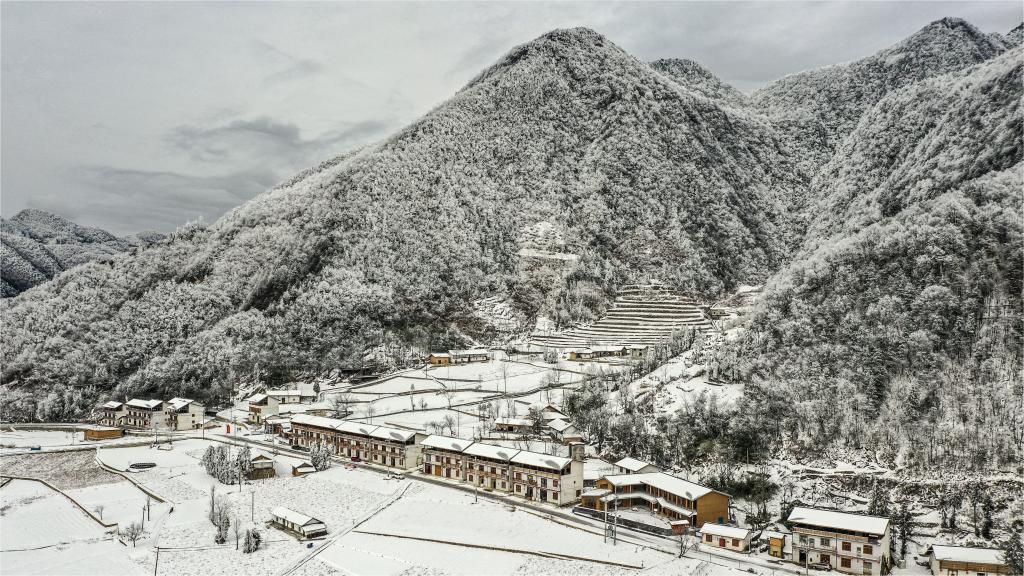Feature: Relief and recovery in quake-hit Xinjiang county
URUMQI, Jan. 28 (Xinhua) -- Despite the nighttime temperatures plunging to minus 20 degrees Celsius, residents in Wushi County, Aksu Prefecture, in northwest China's Xinjiang Uygur Autonomous Region, find comfort and security following the 7.1-magnitude earthquake that struck the area on Jan. 23.
In Karasu Village, Wushi, one of the nearest villages to the quake's epicenter, a resettlement site boasts orderly rows of tents, providing villagers with ample daily necessities and essential supplies.
Wu Hui, who oversees the site, said that with over 60 tents in place, this resettlement site is fully equipped to cater to the living requirements of the relocated villagers, ensuring a smooth daily operation.
In his packed agenda, Wu manages material dispatch, coordinates personnel, and addresses the challenges faced by those affected, ensuring a considerate and efficient response.
Seated around a stove fire in a tent, Kadirya Kurban enjoyed the warmth and company of her family and relatives. The tent had a circle of collapsible beds, cozy blankets, and well-lit lamps, shielding them from the chilly darkness of the night.
"We were terrified when the earthquake happened, but now we feel safe and sound because so many people are helping us," said the 15-year-old who moved into the tent on the day of the earthquake with her family.
According to the China Earthquake Networks Center, there have been over 4,200 aftershocks recorded, with seven aftershocks registering above a magnitude of 5.0, as of 8 a.m. Friday.
"We had naan in the morning, stir-fried tomatoes and eggs for lunch, and Xinjiang lamb rice in the afternoon," said Azgul Yasin, mother of the young girl. She added that the meals provided at the resettlement site are delicious.
"No one in our village was injured during the earthquake," said Kurban Yusup, the father of Kadirya Kurban.
"My home withstood the 7.1-magnitude earthquake, and all my livestock remained unharmed, thanks to the quake-resistant house constructed by the local government," said Mahmut Yusup. He and fellow villagers are waiting for the completion of the assessment of their houses before they could return home.
On Friday, the regional quake-relief headquarters ended its second-level emergency response, moving into the phase of post-disaster assistance and reconstruction.
As the lives of the affected people are gradually stabilizing, the ongoing efforts for reconstruction are advancing steadily.
Outside the tent, volunteer Guo Zhen was busy preparing meals for the next day. Since they arrived at the resettlement site, Guo and his colleagues have seldom strayed far from the food truck, dedicating themselves to tasks like chopping vegetables, stir-frying, steaming rice, and distributing food.
"We rushed here overnight on the day of the earthquake," Guo said. "We feel it is very worthwhile to provide hot meals to the disaster-affected people."
Encircled by her family, Kadirya Kurban said, "Thanks to so much help, I'm sure we'll be home soon."
Photos
 In pics: light installations for 30th Int'l Dinosaur Lantern Show in Zigong, SW China
In pics: light installations for 30th Int'l Dinosaur Lantern Show in Zigong, SW China Snow scenery at section of Wushan Mountain in China's Chongqing
Snow scenery at section of Wushan Mountain in China's Chongqing Pic story: young entrepreneur contributes to scientific visualization in China's Anhui
Pic story: young entrepreneur contributes to scientific visualization in China's Anhui Breathtaking 'blue tears' light up coastal waters in China's Guangdong
Breathtaking 'blue tears' light up coastal waters in China's Guangdong
Related Stories
- In pics: fair in preparation for upcoming Spring Festival in Xinjiang
- Relief efforts in full swing in quake-hit Xinjiang counties
- Int'l representatives, media invited to Xinjiang's "two sessions"
- Xinjiang ports register record high cargo throughput in 2023
- People's daily life returns to normal in quake-hit Xinjiang
Copyright © 2024 People's Daily Online. All Rights Reserved.





